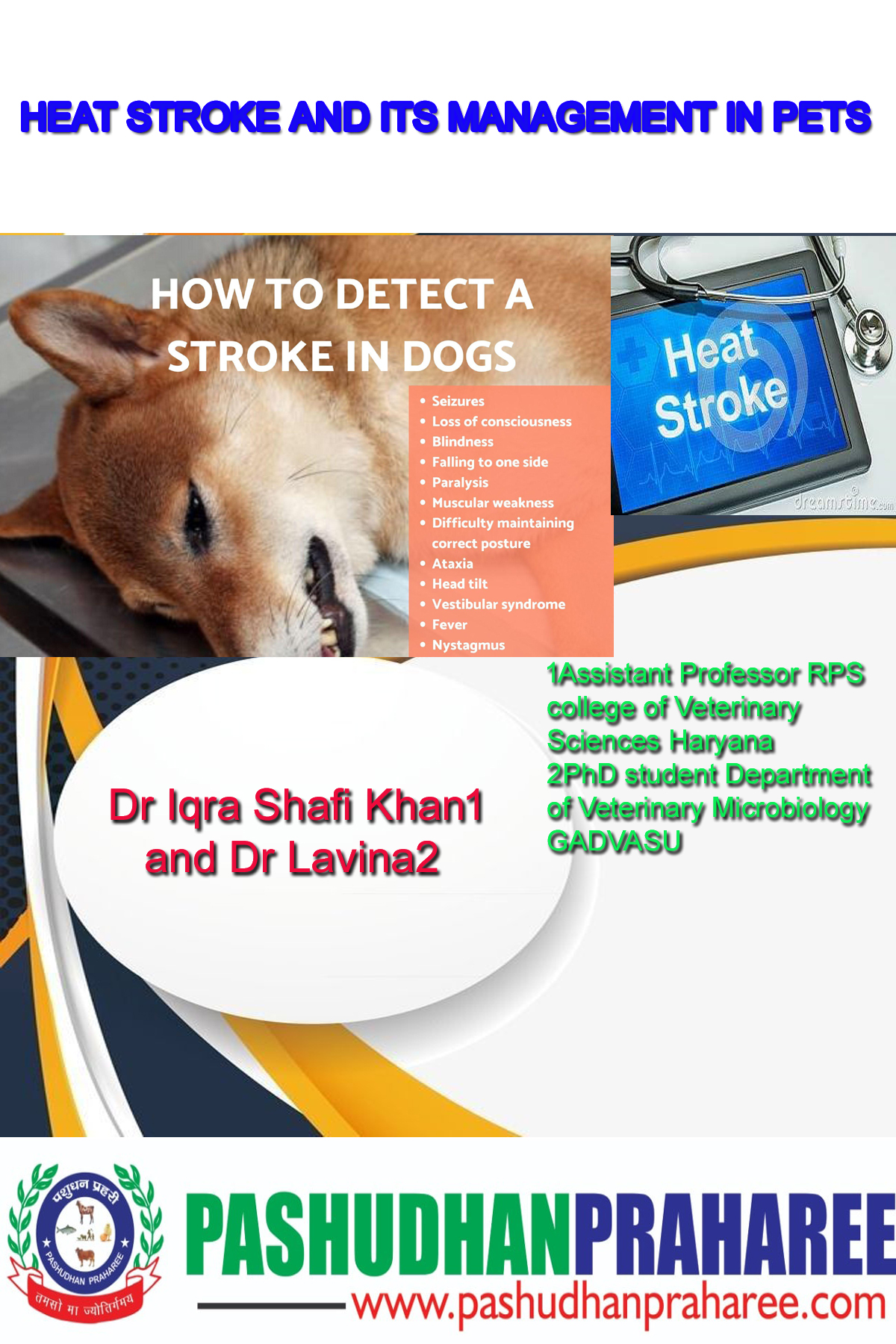HEAT STROKE AND ITS MANAGEMENT IN PETS
Heatstroke in dogs is defined as a non-pyrogenic increase in body temperature above 104°F (40°C) and is accompanied by a variety of systemic symptoms. Heatstroke is a prevalent concern in pets, especially in hot, humid climates, but it can also occur during severe exercise or physical activity. Dogs of any age, breed, or gender can be affected by this life-threatening illness. It can cause an inflammatory response throughout the body, leading to multiple organ failure. To increase the chances of saving the animal’s life, the ability to diagnose and treat heatstroke quickly is critical. The thermoregulatory center in the anterior hypothalamus keeps body temperature within a specific range, or set point. An elevation in the set point in response to sickness can cause pyrogenic hyperthermia or fever.
Types of heat stroke
Heatstroke is classified as exertional or non-exertional.
- Exertional heatstroke occurs when a dog is exercising and is more likely in dogs who have not yet become accustomed to their surroundings. Dogs become less susceptible to heatstroke if a time of temperature acclimatization is permitted. Although the animal is partially acclimated after 10 to 20 days, acclimation might take up to 60 days.
- Nonexertional heatstroke occurs without exertion occurs when a dog is exposed to a high ambient temperature without proper cooling. When a dog is confined to a parked automobile or left in a yard without shade or water, this can occur.
https://www.pashudhanpraharee.com/heat-stroke-in-dogs/
Heatstroke has multiple negative impacts on the body. At body temperatures of 106.7°F to 107.6°F (41.5°C—42°C), direct cytotoxicity occurs. Enzymes and proteins are denatured at high temperatures. The intensity of these effects is determined by the degree of body temperature rise as well as the length of time the temperature is high
Heatstroke in pets: causes and factors
Heatstroke can be caused by a variety of conditions and conditions, including:
- Even when the windows are open and the automobile is sitting in the shade, being trapped in an automobile
- Being confined to a small space with no access to shade or water
- Excessive exertion on a hot and humid day
- Obesity is a problem that affects many people.
- Diseases of the heart and/or lungs
- Age — the most vulnerable animals are the elderly and extremely young.
- Coats that are thick or hefty
- Bulldogs, pugs, and Boston terriers are all short-faced (brachycephalic) breeds that use more energy panting and have narrower nasal passages.
Clinical signs
The most common clinical signs include collapse, tachypnea, shock, panting inappropriate mentation, and signs of coagulopathy, but may also include tachycardia, hyperemia, Muscle tremors, and hyperdynamic to nonexistent pulses. Concurrent central nervous system (CNS) signs can range from slight ataxia to seizures or coma. Rapid breathing or panting: although common in dogs, panting is rare and unusual in cats, but can occur with heatstroke.
Treatment
Intravenous fluids are an important part of heatstroke treatment. Establish IV access in the patient and deliver room temperature crystalloids. For hypovolemic and hemoconcentration heatstroke patients, a bolus of crystalloids is useful. Consider broad-spectrum antibiotics for GI tract support due to the significant risk of bacterial translocation caused by GI impairment. When GI tract injury or CNS abnormalities produce nausea, antiemetics (metoclopramide, dolasetron, maropitant) can benefit. Because GI ulceration is a possibility, give GI protectants. Proton pump inhibitors (omeprazole, pantoprazole) are useful in the prevention and treatment of stomach ulcers. Heatstroke patients frequently have CNS problems may have increased intracranial pressure under such conditions mannitol or hypertonic saline can be used depending upon the condition of the patient. However, both are contraindicated in dehydrated patients. Because cardiac cells are sensitive to thermal injury and ischemia, ventricular arrhythmias are common in patients with heatstroke. Ventricular arrhythmias are caused by abnormalities in the myocardium’s conduction system, which can be addressed with lidocaine. During hospitalization, serial monitoring should include the following:
- Evaluation of the patient’s neurologic condition
- Heart rate, pulse quality, respiratory rate and effort, blood pressure, and ECG are all important factors to consider.
- PT and aPTT
- Packed cell volume and total protein
- Blood glucose and electrolytes
- Lactate and acid-base balance
- Urine output.
The goal of active cooling is to bring the dog to a normal body temperature while avoiding further organ damage. Monitor your temperature every 5 minutes and stop active cooling once your body temperature reaches 103.5°F to 104°F (39.7°C—40°C) to avoid rebound hypothermia.
Avoid the following
- Ice should be avoided because it induces peripheral vasoconstriction, which prevents blood from shunting to the periphery to cool. Ice can harm the skin and make the patient uncomfortable during therapy.
- Avoid gastric lavage and cold water enemas. Aspiration risks may outweigh the benefits of gastric lavage, and cold water enemas may aggravate the GI tract’s already impaired condition.
- Shivering in the patient should be avoided
Prevention of heat stroke
- Keep your dog cool with these helpful hints.
- On hot days, limit physical activity.
- Dogs should never be left in hot rooms or sun traps.
- Long car trips should be avoided.
- Ascertain that they have access to a cool, shady area as well as cool drinking water.
- When going on a walk, always have water with you.
- In the summer, take your dog for a stroll early in the morning or late at night.
- Using cool water, spray your dog.
- Never leave your dog unattended in a parked vehicle.
- https://todaysveterinarypractice.com/todays-technician-heatstroke-in-dogs/
Dr Iqra Shafi Khan1 and Dr Lavina2
1Assistant Professor RPS college of Veterinary Sciences Haryana
2PhD student Department of Veterinary Microbiology GADVASU


